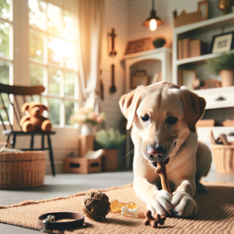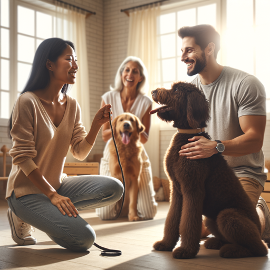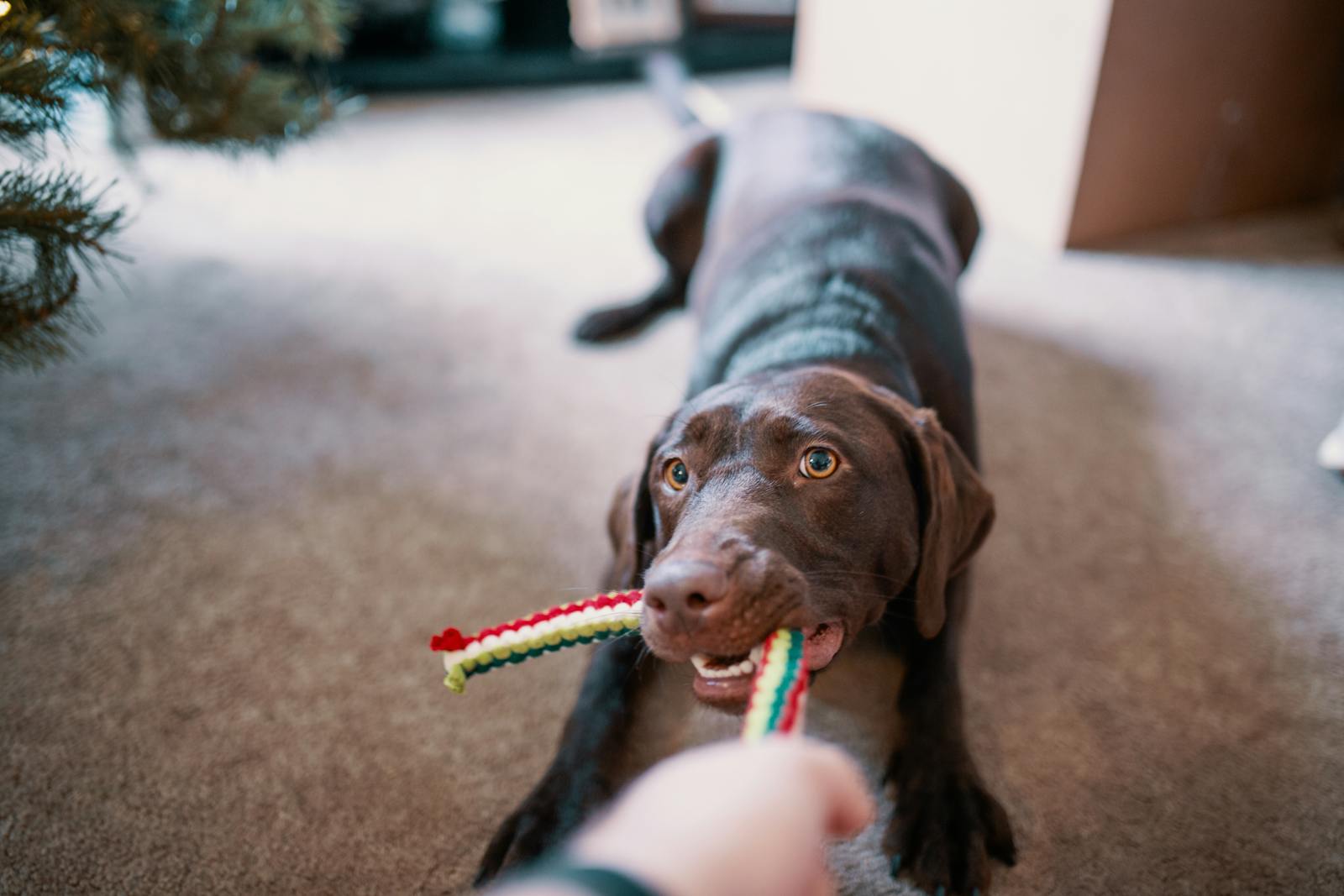Breaking Bad Habits: How to Correct Unwanted Behaviors in Dogs
Understanding Dog Behavior: Exploring the Fundamentals of Canine Habits
Dogs have been humanity’s loyal companions for thousands of years, and their behaviors continue to fascinate us. While we love them for their loyalty and affection, understanding the fundamentals of canine behavior allows us to nurture that relationship and improve communication. This blog will delve into why dogs develop certain habits, explore common behaviors, and provide insights that can help you connect better with your furry friends.
The Roots of Dog Behavior: Nature vs. Nurture
At the core of understanding dog behavior lies the age-old debate of nature versus nurture. Just like humans, a dog’s behavior is influenced by both genetics and environmental factors.
- Genetics: Different breeds have distinct temperaments and behavioral tendencies. For instance, Labrador Retrievers are known for their friendly and social nature, while Border Collies are often more energetic and intelligent, requiring ample mental stimulation. This genetic predisposition can shape a dog’s natural instincts, such as herding, guarding, or hunting.
- Environmental Influences: A dog’s environment during the formative years can greatly impact its behavior. Puppies exposed to various stimuli, social interactions, and training during their critical development stages are more likely to grow into well-adjusted adults. Conversely, a lack of interaction or exposure may lead to fear-based behaviors or aggression down the line.
Understanding how these factors interplay is pivotal in guiding dogs towards positive habits and behaviors.
Common Canine Behaviors: What’s Normal?
As pet owners, it’s crucial to recognize what constitutes normal dog behavior and what might signal an underlying issue. Here’s a brief overview of some common behaviors:
- Barking: While barking is a natural form of communication for dogs, it can serve various purposes from alerting owners of intruders to signaling distress. Understanding the context (or motivation) behind your dog’s barking can help address excessive vocalizations.
- Chewing: Dogs may chew on furniture or belongings for several reasons, including teething, boredom, or anxiety. Providing appropriate chew toys and outlets for energy can help curb destructive chewing.
- Digging: Some breeds are more prone to digging, often due to a natural instinct to unearth or explore their environment. However, digging can also stem from anxiety or excess energy. Providing a designated digging area can satisfy this instinct in a safe way.
- Tail Wagging: While a wagging tail often signifies happiness, the speed and position can indicate different emotions. Learning to decode this subtlety can improve your communication with your dog.
- Body Language: Dogs communicate a great deal through body language. Understanding signals like growling, raised hackles, or a tucked tail can help owners address potential issues before they escalate.
Factors Influencing Dog Behavior
Now that we have a foundation in common behaviors, let’s explore the elements that contribute to these traits and habits:
- Socialization: Early exposure to various environments, people, animals, and experiences can help dogs develop confidence and adaptability. Socialization classes for puppies can be particularly beneficial in fostering positive behaviors.
- Training and Commands: Consistent training can help shape your dog’s behavior positively. Basic commands such as “sit,” “stay,” and “come” can assist in establishing a communication chain that can manage your dog’s antics more effectively.
- Routine and Structure: Dogs thrive on routine. Regular meal times, exercise schedules, and training sessions can provide a sense of structure and security, alleviating anxiety and promoting good behavior.
- Health and Wellness: Physical health plays a critical role in behavior. Health issues such as pain, allergies, or even dietary imbalances can lead to changes in behavior. Always consult with a veterinarian if you notice sudden behavioral changes.
Tips for Managing Dog Behavior
Improving your understanding of behavior is just the first step; implementing strategies to manage and modify behaviors can enhance your relationship with your dog. Here are some practical tips:
- Observe and Record: Keep a journal of your dog’s behaviors and the circumstances surrounding them. This can help identify patterns and triggers.
- Positive Reinforcement: Encourage positive behavior through rewards such as treats, praise, or playtime. This approach fosters a learning environment that reinforces good habits rather than punishing unwanted behaviors.
- Exercise and Mental Stimulation: Ensure your dog is getting enough physical exercise according to its breed needs. Engaging in regular activities such as long walks, playtime, or puzzle toys can reduce anxiety and curb negative behavior.
- Establish Boundaries: Train your dog on acceptable behaviors and stick to these boundaries consistently. This will help your dog understand what is expected and reduce confusion.
- Seek Professional Help: If you ever feel overwhelmed by your dog’s tendencies, such as persistent aggression or anxiety, do not hesitate to consult a professional dog trainer or behaviorist who can provide guidance tailored to your dog’s needs.
Conclusion: Building a Stronger Bond Through Understanding
Understanding dog behavior is not just about deciphering random habits—it’s about building a deeper connection with your canine companion. By acknowledging the influences that shape these behaviors, you’ll cultivate a more harmonious relationship based on communication, trust, and care.
As you embark on or continue your journey with your dog, remember that patience and love are key. Observe your dog, listen to their needs, and create an environment conducive to positive behaviors.

Identifying Unwanted Habits in Dogs: Recognizing Behaviors That Require Attention
As much as we adore our four-legged companions, they are not without their quirks and unwanted behaviors. Identifying these habits early on is essential to ensure a harmonious living environment for both pets and their owners. Often, what some may perceive as a simple annoyance may be a symptom of underlying stress or boredom, and recognizing these signals can help create a positive atmosphere for your dog. In this section, we will explore common unwanted habits many dogs exhibit and offer insights to help you address and manage these behaviors effectively.
Excessive Barking: Know the Triggers
Barking is a natural form of communication for dogs. However, excessive barking can become a nuisance and can indicate that something may be off in your dog’s environment or emotional state.
Reasons for Excessive Barking:
- Attention-Seeking: Dogs may bark to get attention from their owners or other pets. This behavior can often be inadvertently reinforced if you respond to their barking.
- Boredom: Lack of physical exercise or mental stimulation can lead to excessive barking as dogs attempt to entertain themselves.
- Alertness or Guarding: Many dogs instinctively bark to alert their family of perceived threats or unusual noises.
Actionable Tips to Manage Barking:
- Identify Triggers: Observe what leads to excessive barking. Is it the mailman? Other dogs passing by? Understanding these triggers is essential.
- Provide Training: Teaching commands such as “quiet” or “enough” can help in managing barking. Reward your dog when they respond appropriately.
- Increased Exercise: Ensure your dog receives adequate physical activity each day to mitigate restlessness and boredom.
Chewing: More Than Just Puppy Behavior
While chewing is particularly common among puppies, adult dogs can also develop destructive chewing habits that may be frustrating for owners. This behavior can arise from various causes and understanding these motivations will help you address the issue.
Reasons for Destructive Chewing:
- Teething: Puppies often chew as they transition from baby teeth to adult teeth, seeking comfort during this painful process.
- Anxiety: Chewing can also be a coping mechanism for dogs, particularly those experiencing separation anxiety or stress.
- Boredom: Just like barking, if your dog doesn’t have appropriate toys or activities, they may turn to furniture or shoes for entertainment.
Actionable Tips to Curb Chewing:
- Provide Appropriate Chew Toys: Invest in durable chew toys that will satisfy their natural chewing instincts while keeping them occupied.
- Redirect Behavior: If you catch your dog in the act of chewing something inappropriate, gently redirect them to their chew toy with positive reinforcement.
- Increase Mental Stimulation: Engage your dog in interactive play and puzzle toys that challenge them and provide necessary stimulation to prevent unwanted habits.
Jumping: A Trendy Greeting That Can Become Problematic
Jumping up is a common behavior among dogs, particularly when they are excited or eager to greet people. While it may seem playful, it can be problematic, especially for guests who may not appreciate a joyful dog leaping onto them.
Reasons for Jumping:
- Excitement: Dogs often jump as a way of expressing their enthusiasm to greet their owners or visitors.
- Attention Seeking: This behavior is frequently reinforced when clients reward jumping with attention, making it a learned behavior.
Actionable Tips to Manage Jumping:
- Teach an Alternative Behavior: Train your dog to sit when greeting people instead of jumping. Reward them for sitting calmly.
- Stay Consistent: Ensure that all family members and friends are on the same page about allowing jumping as it can be confusing for the dog.
- Provide Calm Introductions: When guests arrive, consider having your dog on a leash and practice controlling their excitement by rewarding calm behavior.
Digging: Uncovering the Truth Behind This Common Behavior
Digging can be a more complex behavior to manage, as it can stem from a variety of motivations, many of which are deeply ingrained instincts.
Reasons for Digging:
- Searching for Comfort: Dogs may dig to create a comfortable spot to lie down in, finding security in their instinctual behaviors.
- Chasing or Exploring: Some dogs dig due to a desire to unearth critters or explore their environment.
- Anxiety or Frustration: Similar to barking and chewing, digging can be a sign of stress or boredom as a coping mechanism.
Actionable Tips to Reduce Digging:
- Create a Designated Digging Area: If your dog enjoys digging, consider providing a specific spot where they are allowed to dig, such as a sandbox.
- Redirect With Activities: Engage your dog with other stimulating physical activities, such as fetch or hiking, to alleviate their desire to dig.
- Monitor and Manage: Keep an eye on your dog outdoors; when they begin to dig, redirect them to acceptable behavior.
Conclusion: A Unified Approach to Unwanted Behaviors
Identifying unwanted habits in your dog is the first step toward creating a more peaceful, enjoyable environment for both you and your pet. By recognizing the core motivations behind behaviors like excessive barking, chewing, jumping, and digging, you can implement effective training methods to address and manage them.
Creating a loving yet structured environment enables dogs to thrive emotionally and behaviorally. As you navigate your journey with your furry friend, remember to be patient and consistent in your approach.

The Impact of Environment on Dog Behavior
A dog’s environment plays a pivotal role in shaping its behavior. From the comfort of your home to the social interactions your dog experiences, every aspect of its surroundings can either contribute to or hinder its emotional and behavioral well-being. This section will examine how critical environmental factors such as the home environment, social interactions, and daily routines significantly influence a dog’s behavior and the overall importance of providing a stable environment for fostering positive behaviors.
The Home Environment: A Haven for Dogs
The home environment is the cornerstone of a dog’s life, and it significantly influences their behavior. Here are some essential factors to consider:
- Safety and Security: A secure environment allows dogs to feel safe and reduces anxiety. A chaotic or unsafe living space can lead to fear-based behaviors such as barking, aggression, or hiding. Make sure your home is free from hazards and provides a comfortable space for your dog to retreat to when they need a break.
- Comfortable Spaces: Dogs need their own space to relax. A designated area with a cozy bed, toys, and blankets can help create a sense of ownership and security. Ensure that their space is away from excessive noise or activity to minimize stress.
- Consistency and Routine: Dogs thrive in environments that offer structure. A consistent schedule for feeding, exercise, and training helps dogs understand what to expect, which can lessen anxiety. For example, if meals are served at the same time every day, your dog learns to anticipate these events, providing a reassuring rhythm to their day.
Social Interactions: The Influence of Relationships
Socialization is pivotal in shaping a dog’s personality and behavior. The quality of their interactions with other dogs, pets, and people can lead to various outcomes:
- Positive Reinforcement through Socialization: Introducing your dog to diverse environments and individuals during their formative years is essential. Positive experiences with new people and pets can reduce fearfulness and encourage friendly behaviors. Consider enrolling your pup in puppy kindergarten or doggy daycare, where they can interact with other animals under controlled circumstances.
- Impact of Owner-Reactions: How a dog reacts during social interactions is often influenced by their owner’s behavior. If an owner approaches new encounters with anxiety or fear, the dog may mimic those feelings, leading to undesirable behaviors such as aggression or withdrawal. Practice calmness and positivity during introductions to encourage your dog to view new experiences as opportunities.
- Group Dynamics: Dogs are social animals, and their behavior can vary greatly depending on the group they are around. For instance, a shy dog may feel emboldened within a pack of friendly, confident dogs but could become fearful when isolated or surrounded by aggressive canines. Monitoring playdates and group activities is essential to ensure a positive experience.
Routines: Building Predictability and Stability
Having a daily routine is crucial for dogs. Here’s how establishing and maintaining routines can contribute to positive dog behavior:
- Structured Activities: Incorporate routine activities such as regular walks, playtime, and training sessions. This structure helps to channel a dog’s energy and reinforces good behavior.
- Expectations and Boundaries: Clearly defined routines set a standard for acceptable behavior. For example, if your dog knows that playtime follows their morning walk, they will look forward to that interaction and channel their excitement appropriately.
- Reduction of Behavioral Issues: A predictable routine can significantly reduce anxiety and behavioral problems in dogs. Dogs that experience unpredictability in their lives may develop stress or separation anxiety, leading to destructive behaviors, barking, or aggression.
The Importance of a Stable Environment
Creating a stable and predictable environment is key to ensuring that your dog exhibits positive behaviors. Here’s why:
- Emotional Well-being: A stable environment can significantly improve a dog’s emotional health. Dogs are sensitive creatures; when they feel settled and secure in their environment, they are less likely to exhibit behaviors linked to anxiety, such as barking excessively or chewing on furniture.
- Improved Learning and Training: Dogs learn best in a structured environment where they understand what behavior is expected of them. Consistency in commands, rewards, and interactions leads to better training outcomes, paving the way for a well-behaved pup.
- Fostering Positive Relationships: When dogs feel safe and comfortable, they are more inclined to bond with their owners. This bond is crucial for building trust and loyalty, leading to improved communication and cooperation during training sessions.
Conclusion: A Comprehensive Approach to Dog Behavior
Understanding the role of environment in influencing dog behavior is crucial for any pet owner. By ensuring a safe, structured, and social atmosphere for your furry friend, you can foster positive behaviors and strengthen the bond you share. As you navigate your journey with your dog, consider how their environment may be impacting their actions and adjust accordingly.

Consistency is Key: The Necessity of Consistent Training and Reinforcement in Correcting Unwanted Behaviors
In the world of dog training and behavior modification, consistency plays a vital role in shaping a canine’s habits. Consistent training and reinforcement are crucial elements in correcting unwanted behaviors and establishing a well-adjusted and obedient companion. In this section, we will explore the necessity of consistency in commands, rewards, and expectations and provide practical tips to help you maintain that consistency effectively.
The Importance of Consistency in Training
When it comes to training your dog, consistency ensures that your canine companion understands what is expected of them. Without a solid framework of consistent commands and responses, dogs can quickly become confused, leading to frustration for both the pet and the owner. Let’s delve into why consistent training is essential:
- Clarity in Communication: Dogs thrive on clear communication. When you use the same command for the same action every time, your dog can more quickly comprehend what you are asking of them. This reduces misinterpretation and helps build a predictable training environment.
- Strengthening Learning: Repeated exposure to the same commands and routines reinforces your dog’s learning. It allows them to associate specific words or signals with particular actions, solidifying their understanding and improving their response.
- Building Trust: Consistency helps create a stable learning environment, which fosters trust between you and your dog. When your dog knows what to expect from you, it can feel more secure and confident in its training.
Maintaining Consistency: Command Strategies
To build a consistent training routine, focus on the following strategies for commands:
- Use Clear and Simple Commands: Stick to short, easily understandable commands like “sit,” “stay,” and “come.” Avoid using multiple words or phrases for the same command to prevent confusion.
- Be Mindful of Tone: Your tone can significantly influence how your dog responds. Maintain a consistent tone—whether it’s authoritative or encouraging—so your dog understands the intensity of your requests.
- Practice Regularly: Set aside time every day for training sessions. Engaging in routine practice strengthens your dog’s learning while reinforcing their familiarization with commands.
Reinforcement Techniques: Rewards Matter
Positive reinforcement is one of the most effective methods for encouraging desired behaviors. The key is to maintain consistency in how you reward your dog for good behavior:
- Immediate Rewards: Deliver treats or praise immediately after your dog successfully follows a command. This timing helps your dog connect their action with the reward effectively.
- Establish Reward Hierarchy: Develop a hierarchy of rewards that corresponds to the complexity of the behavior. For example, if your dog performs a basic command, a simple verbal praise may suffice, while more complex behaviors might warrant a tasty treat or extra playtime.
- Be Consistent in Rewards: Use the same rewards consistently to reinforce the behavior. If you can only reward with treats occasionally, your dog may become confused about when the reward applies. Consistency in rewards reinforces desired behaviors reliably.
Managing Expectations: Setting Boundaries
Training is not just about commands—it also involves setting clear and consistent expectations for behavior. Here’s how to do it effectively:
- Establish Rules: Define what behaviors are acceptable and unacceptable in your household. Make sure all family members adhere to these rules to avoid mixed signals.
- Communicate Boundaries: Use clear commands to enforce boundaries. For instance, if your dog jumps up in excitement, consistently use “off” and guide them down.
- Be Patient: Behavior modification takes time. Stay committed to your training routine and avoid frustration. Progress will be gradual, so celebrate small victories along the way.
Real-World Examples of Consistent Training
To illustrate the importance of consistency in training, consider two dog owners tackling unwanted behaviors:
- Example 1: Sarah has a Labrador Retriever who tends to jump on people when excited. Early on, Sarah would occasionally allow the dog to jump up during playtime, inadvertently reinforcing the behavior. However, after recognizing her inconsistency, Sarah decided to enforce a “down” command every time her dog jumps up. By consistently applying this command and rewarding her dog when it stays down, she successfully curbed the jumping behavior.
- Example 2: Mark owns a Border Collie that barks excessively at the mailman. Initially, Mark tried various commands without a consistent approach, leading to confusion and continued barking. After learning about the importance of consistent training, Mark started using the command “quiet” every time his dog barks at the mailman, rewarding her when she complied. His commitment to this technique resulted in reduced barking and a more peaceful home environment.
Conclusion: The Essential Role of Consistency in Dog Training
In summary, consistency is non-negotiable when it comes to effective dog training. Clear commands, steady rewards, and well-defined boundaries create an environment where dogs can thrive and learn. Remember, dog training is a journey requiring patience, time, and dedication.
By prioritizing consistency in your training efforts, you’ll not only correct unwanted behaviors but also strengthen the bond you share with your canine companion.

Positive Reinforcement: A Powerful Technique for Encouraging Desirable Behaviors in Dogs
When it comes to training our canine companions, positive reinforcement has emerged as a powerful technique for encouraging desirable behaviors. Rather than relying on punishment or negative feedback to deter unwanted habits, this method focuses on rewarding good behavior with treats, praise, and affection. This approach not only reinforces desired actions but also strengthens the bond between you and your dog.
How Positive Reinforcement Works
Positive reinforcement operates on the principle that behaviors followed by rewards are likely to be repeated. This can be especially effective in modifying behaviors and fostering a positive learning environment. Here are some key components:
- Immediate Reward: For positive reinforcement to be effective, the reward should occur immediately after a desired behavior. This helps your dog make the connection between their action and the reward.
- Consistency: Consistently rewarding good behavior is crucial. If you reinforce certain behaviors inconsistently, your dog may become confused about what actions earn rewards.
- Personalized Rewards: Every dog is different, meaning that preferences for rewards can vary widely. While some dogs may be motivated by tasty treats, others may respond better to praise, playtime, or affectionate petting. Understanding what drives your dog is key to successful training.
Effective Reward Strategies
Implementing positive reinforcement can be tailored through various reward strategies to maximize its effectiveness in promoting good behavior.
- Using Treats: Treats can be a powerful incentive during training. Start with small, soft morsels that your dog can quickly consume. This avoids the interruption of training sessions and keeps your dog engaged. Here are a few tips:
- Variety: Use different treats to keep your dog interested. For instance, try high-value treats like chicken or special dog biscuits for more challenging commands.
- Healthier Options: Opt for low-calorie treats to prevent overfeeding. You can also use fruit or vegetables like carrots or apples (without seeds) as healthy alternatives.
- Verbal Praise and Affection: Dogs thrive on affection and praise from their owners. Use an enthusiastic tone of voice to express your approval when your dog performs the desired behavior. Pair verbal praise with physical affection to reinforce the bond. For example:
- Cheering: Use words like “Yes!” or “Good dog!” while petting them or offering scratches behind their ears.
- Playtime as a Reward: Incorporating playtime as a reward can be extremely effective, especially for high-energy dogs. After they perform a command correctly, reward them with a game of fetch or tug-of-war. This not only reinforces their behavior but also allows them to expend energy productively.
Real-World Examples
Let’s consider a few real-world scenarios to illustrate the effectiveness of positive reinforcement:
- House Training: If your puppy eliminates outside instead of on the carpet, immediately reward them with praise or a treat. This reinforces the behavior, making them more likely to repeat it in the future.
- Leash Training: When teaching your dog to walk nicely on a leash, reward them when they remain by your side without pulling. If your dog stays close for even a few steps, offer a treat or praise, encouraging them to continue.
- Responding to Commands: For commands like “sit” or “come,” ensure to reward your dog promptly when they perform the command correctly. This will help them establish a clear understanding of their actions being rewarded.
Overcoming Challenges with Positive Reinforcement
While positive reinforcement is effective, challenges may arise in specific training scenarios. Here are some tips to address those challenges:
- Distractions: Dogs are easily distracted by their environment. If your dog is not responding to commands, try practicing in a quiet space free from distractions at first, then gradually increase difficulty as they master behaviors.
- Impatience: It can be tempting to give up when training takes longer than expected. Remember, it’s essential to be patient and consistent for the best results. Frequent short training sessions are often more effective than longer ones.
- Reinforcing Unwanted Behaviors: Be aware that inadvertently rewarding unwanted behaviors, like jumping up or begging, can result in confusion. It’s essential to redirect and reinforce appropriate behaviors consistently.
Conclusion: Building a Positive Training Environment
Emphasizing positive reinforcement is a holistic approach to dog training that nurtures and builds trust between you and your dog. By recognizing the value of treats, praise, and affection as effective rewards, you set your dog up for success in learning and obtaining good habits.
Integrating these techniques into your daily routine can lead to a happier and more well-behaved pet.

Timing Your Rewards: The Science of Immediate Reinforcement
When it comes to training and shaping dog behavior, timing is everything. One of the most effective techniques in dog training is immediate reinforcement, which plays a crucial role in helping dogs understand precisely what is expected of them at any given moment. This section explores why timely rewards are essential, how they work, and practical strategies for their effective implementation.
Understanding Immediate Reinforcement
Immediate reinforcement refers to the practice of rewarding a dog right after it exhibits the desired behavior. This swift connection between action and reward enables dogs to form a clear association, making it easier for them to learn and repeat those behaviors in the future. Studies have shown that the most effective timing for reinforcement is within seconds of the desired action. Here’s how immediate reinforcement can be beneficial:
- Clarity in Communication: By rewarding your dog immediately, you eliminate ambiguity. For instance, if your dog sits on command and you give a treat within a moment, they can directly associate the treat with the “sit” action.
- Fostering Motivation: Quick rewards can increase your dog’s motivation to perform desired behaviors, making training sessions more productive and enjoyable. Dogs learn much faster when they know they’ll receive a treat or praise right after completing a task.
The Importance of Timing
The effectiveness of reinforcement relies heavily on timing. Here’s a breakdown of why this aspect matters:
- Attention Span: Dogs have limited attention spans, especially when they are excited or distracted. Immediate reinforcement ensures that the reward occurs while the behavior is still fresh in their mind.
- Behavioral Conditioning: Just like in any form of learning, conditioning plays a significant role. When dogs receive a reward right after performing a task, they more likely will repeat that action, ultimately leading to positive behavioral changes.
- Building Habits: Consistency in timing aids in establishing strong habits. If a dog consistently receives a treat immediately after sitting, it becomes ingrained as a habitual action over time.
Tips for Effective Timing
To optimize your reinforcement timing and enhance your dog training experience, keep these actionable tips in mind:
- Be Prompt: Always reward within 1-2 seconds after your dog exhibits the desired behavior. This could be a verbal “Good dog!” followed by a treat or a favorite toy.
- Use a Marker: Incorporating a clicker or a distinct verbal cue can signal your dog that they’ve done something right, followed immediately by a reward. This method allows for a clear association between behavior and reward even if you can’t give the treat instantly.
- Monitor Your Dog’s Engagement: Pay attention to your dog’s focus and energy levels. The more engaged they are in training, the better the timing. Try to avoid distractions or interruptions during these moments.
- Start Simple: Especially during the initial phases of training, simplify commands to encourage successful behaviors. Once your dog associates the reward with a specific action, you can gradually introduce more complex commands.
- Stay Consistent: Always reward the same behavior with the same prompt. For instance, if your dog sits and you say “Sit!” followed by a treat, repeat this pattern until it becomes a natural response for them.
Real-World Examples of Immediate Reinforcement
Consider the scenario of teaching your dog to roll over. During training, you give a command to roll over, and the moment your dog successfully performs the action, you immediately deliver a treat and verbal praise. If you wait too long or only reward after the training session, the link between the behavior and the reward becomes muddled. By consistently reinforcing right after the action, your dog will quickly learn to associate rolling over with positive outcomes.
Another example is leash walking. If your dog walks nicely beside you without pulling, rewarding them within seconds of them exhibiting good behavior reinforces that walking alongside you is desirable. Over time, your dog will naturally seek to repeat that behavior to gain further rewards.
Conclusion: Mastering Timing Enhances Learning
Harnessing the power of immediate reinforcement is a game-changer in dog training. By emphasizing the importance of timing, pet owners can create an environment where dogs understand expectations more clearly and feel motivated to engage in positive behaviors. As you continue your training journey, remember that effective reinforcement comes from being observant, consistent, and prompt in your rewards.

Setting Realistic Goals
Setting Realistic Goals: A Practical Guide to Achieving Training Success
Once you’ve established a solid understanding of your dog’s behaviors, the next crucial step is to set realistic training goals that can guide you towards correcting unwanted habits. Effective goal setting can instill confidence, create structure, and pave the way for a happy, well-adjusted pet. In this section, we’ll outline practical strategies for setting achievable goals that promote success and harmony in your home.
Why Setting Realistic Goals Matters
Setting goals in dog training is more than merely a good idea; it’s a necessity. Realistic goals help:
- Provide Focus: Goals clarify what you want to achieve, directing your training sessions towards specific outcomes.
- Track Progress: Measuring your dog’s improvement helps adjust methods as needed and boosts your confidence as a trainer.
- Build Confidence: Achieving smaller milestones makes it easier for both you and your dog to celebrate successes, reinforcing positive behavior and encouraging further learning.
With these benefits in mind, let’s delve into how to create and implement these goals effectively.
Breaking Down Your Goals into Manageable Steps
Breaking training objectives into smaller chunks can significantly enhance success rates. Here’s how to do it:
- Identify the Behavior: Start by clearly identifying which unwanted behavior you wish to address. For example, if your dog jumps on guests, delineate this behavior as your primary focus.
- Set Specific Goals: Formulate clear, specific goals related to that behavior. If the unwanted habit is jumping, your goal might be: “By the end of the month, my dog will remain seated when guests enter the house.”
- Create Actionable Steps: Divide your overarching goal into actionable steps, making them simple and achievable. Taking our jumping example, here’s how you might break it down:
-
- Week 1: Practice “sit” on cue in a distraction-free environment.
- Week 2: Introduce a simulated guest (a friend or family member) to practice “sit” with realistic distractions.
- Week 3: Increase distractions by practicing in more stimulating environments, such as a park.
- Week 4: Set up a real scenario with actual guests, following the same training.
- Regularly Review and Adjust: Regular evaluation is crucial. If certain steps are not yielding the desired results, be flexible in your approach. Modify the goals or steps as necessary, keeping your dog’s needs and progress in mind.
Utilizing Positive Reinforcement
Positive reinforcement is a powerful tool in dog training, enhancing the likelihood of desired behaviors repeating. Here are actionable tips on how to incorporate it:
- Reward Immediately: Timing is key; always give treats or praise immediately after your dog performs the desired action to cement the connection in their minds.
- Be Consistent: Consistency in how and when you reward your dog reinforces learning—ensure everyone in your household is on the same page about reward usage.
- Vary the Rewards: As your dog learns, mix up the types of rewards to maintain interest—use treats some days, playtime on others, or even a favorite toy.
Real-World Example: A Case of Excessive Barking
Let’s consider a practical example involving a dog with excessive barking. Here’s how setting realistic goals can help:
- Identify Behavior: Your dog barks excessively when the mailman arrives.
- Set a Goal: “My dog will remain quiet during mail delivery after a month of training.”
- Break Down Goals:
-
- Week 1: Teach the “quiet” command when your dog barks at home.
- Week 2: Work on “quiet” with distractions like the sound of the mail truck outside.
- Week 3: Practice with a friend mimicking the mailman knocking on the door.
- Week 4: Integrate all previous practices during actual mail delivery.
- Positive Reinforcement: Reward your dog every time they stay calm and quiet during mail delivery.
Keeping Track of Progress
Monitoring progress is essential to successful dog training. Here are tips to help you keep a record that is both practical and effective:
- Daily Journaling: Maintain a training journal to jot down your dog’s responses, new skills acquired, and any adjustments made to the training process. This practice not only tracks achievements but also highlights areas needing improvement.
- Photographic Evidence: Consider taking photos or videos to visually track progress. They can serve as strong motivators, showing how far you and your dog have come in your training journey.
- Set Milestones: Celebrating small victories helps keep your training journey enjoyable. Set mini-celebrations for when your dog achieves certain milestones—whether that means a special treat or extra playtime.
Conclusion: A Path to Success Through Realistic Goals
Setting realistic goals for dog training is the cornerstone of effective behavior modification. By breaking down overarching ambitions into manageable steps, utilizing positive reinforcement, and continually tracking progress, you’re not only promoting successful outcomes but also enhancing the bond between you and your canine companion.

Training Techniques: An Overview of Effective Methods for Your Canine Companion
As we’ve explored the intricacies of dog behavior, the next logical step in nurturing our bond with our furry friends is understanding the various training techniques available. Just as every dog is unique, so too are the training methods that work best for them. This overview will introduce several popular training techniques, including clicker training, leash training, and crate training, helping you to choose the right approach for your canine companion.
Clicker Training: Promoting Positive Behavior through Sound
Clicker training is a popular method that employs a small handheld device that makes a distinct sound (the “click”) to mark desired behaviors at the precise moment they occur. This method is based on positive reinforcement, where good behaviors are rewarded with treats, praise, or playtime. Here’s how to get started with clicker training:
- Introduce the Clicker: Start by clicking the device and immediately giving your dog a treat. This helps your dog associate the sound with a reward.
- Timing is Essential: Click at the exact moment your dog performs the desired behavior, whether it’s sitting, lying down, or any other command.
- Gradually Fade Out the Click: Once your dog has learned a command, you can begin to reduce the frequency of the clicks and rewards while maintaining the behavior.
Real-World Example: Lisa noticed that her dog Max would jump on guests when they arrived. Using clicker training, Lisa clicked as soon as Max’s paws touched the ground upon guest arrival and rewarded him. Over time, Max learned that remaining calm and seated while guests entered was rewarded, significantly reducing his jumping behavior.
Leash Training: Making Walks Enjoyable and Safe
Leash training is essential for ensuring that your dog walks politely and safely on a leash. Proper leash etiquette not only makes walks more enjoyable for both pet and owner but also helps your dog develop good manners in public. Here are some key components to this technique:
- Choose the Right Equipment: Select a leash and collar or harness that suits your dog’s size and temperament. A front-clip harness may be beneficial for strong pullers.
- Start Indoors: Before venturing outside, practice short leash walks indoors where distractions are minimal. This will help your dog learn to walk beside you.
- Use Positive Reinforcement: Reward your dog for walking beside you rather than pulling ahead. Use treats or verbal praise when your dog stays close.
- Practice Consistently: Take your dog on regular walks, gradually increasing their duration and complexity as they grasp the concept of leash walking.
Real-World Example: After adopting Bella, a spirited Labrador, John struggled with her eagerness to pull him during walks. After implementing the leash training techniques, including rewarding Bella for walking calmly beside him, he noticed significant improvements. Their walks became more enjoyable, allowing them to explore the neighborhood without the constant tug of war.
Crate Training: Providing a Safe Haven for Your Dog
Crate training can be an invaluable tool for managing your dog’s behavior and providing them with a sense of security. When used properly, a crate can serve as a safe haven for your dog, helping with separation anxiety, house training, and travel. Here’s how to effectively crate train your dog:
- Choose the Right Crate Size: Ensure your crate is just big enough for your dog to stand, turn around, and lie down comfortably.
- Make it Inviting: Place their favorite blanket or toys inside to create a welcoming environment. You can also leave treats or meals in the crate initially to build positive associations.
- Use Gradual Introductions: Start by encouraging your dog to explore the crate with the door open. Gradually close the door for short periods, always reinforcing calm behavior with treats or affection.
- Establish a Routine: Incorporate the crate into your dog’s daily routine, using it during rest periods, overnight, or when you’re away.
Real-World Example: Emily was apprehensive about using a crate with her new puppy, Oliver. After following a gradual introduction protocol, Oliver began to see the crate as his personal space, which allowed Emily to reduce anxiety during car trips and while she was at work.
Choosing the Right Training Method for Your Dog
When selecting a training technique, consider your dog’s unique personality, learning style, and your lifestyle. Here are some factors to consider:
- Temperament: Highly energetic or easily distracted dogs may benefit more from structured techniques like leash or crate training.
- Learning Style: Dogs respond differently to training cues; some may thrive on positive reinforcement, while others may need more tactile approaches.
- Your Goals: Define what you want to achieve—is it basic obedience, house training, or a specific behavior modification?
Conclusion: Tailoring Techniques to Your Canine Companion
The foundation of effective dog training lies in choosing the right technique that caters to your dog’s behaviors and your specific needs as a pet owner. Each method, from clicker to leash to crate training, offers unique benefits that can help foster a positive relationship between you and your furry friend. As you embark on your training journey, be patient, remain consistent, and always keep your dog’s well-being at the forefront of your approach.

Socialization
The Role of Socialization in Behavior Correction
Socialization is one of the most crucial aspects of a dog’s early development and ongoing behavior management. The process of socialization helps dogs learn how to interact with different environments, people, and other animals—experiences that play a significant role in curbing unwanted behaviors. Let’s explore how effective socialization can influence behavioral correction in dogs.
Understanding the Importance of Socialization
Socialization involves exposing your dog to various settings and experiences during critical stages of development, particularly within the first 16 weeks of age. However, adult dogs can also benefit from continued socialization. This exposure serves to:
- Build Confidence: Socialization helps dogs feel comfortable in new situations, reducing fear and anxiety. A confident dog is less likely to exhibit behaviors such as aggression or excessive barking.
- Promote Positive Interactions: Encounters with diverse people and dogs can enhance your dog’s social skills, encouraging friendly behavior instead of fear-based actions.
- Reduce Behavioral Issues: Early and continuous exposure diminishes the likelihood of developing phobias or problematic habits formed from inadequacy in social situations.
Techniques for Effective Socialization
To achieve the benefits of socialization, here are some actionable techniques on how and when to socialize your dog:
- Puppy Classes: Enroll your puppy in classes designed for socialization. These classes provide controlled environments where puppies can meet other dogs while learning commands and practicing good behavior.
- Meet in Safe Settings: Organize playdates with well-behaved, vaccinated dogs to ensure that your dog can engage positively with peers in a safe space.
- Exposure to Everyday Stimuli: Take your dog on walks in different environments—busy streets, parks, dog-friendly cafes—exposing them to various sights and sounds they may encounter in daily life.
- Gradual Introduction: When exposing your dog to new experiences, do so gradually and at a pace they can handle. This could mean encountering one new dog at a time or ensuring that the hustle and bustle of a dog park isn’t overwhelming.
- Be Mindful of Body Language: Pay attention to your dog’s body language during socialization. If they show signs of stress or fear, it may be essential to give them a break or remove them from the situation to avoid negative associations.
Real-World Examples of Successful Socialization
Consider a dog that responds with fear and aggression during encounters with other dogs. By introducing that dog to a well-mannered, calm canine at the local dog park, the owner can create situations where this dog gradually learns that other dogs do not always pose a threat. Over time, as positive interactions increase, the fearful dog softens their responses—eventually playing joyfully and learning proper dog etiquette through observation and participation.
Similarly, take the example of an adult dog, Salmon, who became increasingly reactive to new guests in his home. His owner began hosting controlled gatherings with familiar and calm friends while providing Salmon with treats when guests arrived. Over time, Salmon learned that visitors equated to positive experiences (like tasty snacks) rather than threats, thus improving his behavior around new people.
Incorporating Different Environments and People
Exposing your dog to varied environments and people facilitates well-rounded behavior. Here’s how to integrate this into daily routines:
- Nature Walks: Regular walks through different landscapes—parks, beaches, urban areas—exposes dogs to various scents, weather conditions, and experiences that build resilience.
- Community Events: Attend pet-friendly community events. From dog shows to charity walks, these events are excellent opportunities for socialization.
- Family and Friends: Encourage visits with friends and family members to expose your dog to different personalities and behaviors. This helps them learn how to interact with various approaches and energy levels.
- Dog Sporting Events: Participating in agility training or obedience courses can also enhance a dog’s ability to navigate novel environments, providing both mental and physical stimulation.
Helping to Curb Unwanted Behaviors
When faced with unwanted behaviors such as excessive barking, chewing, or aggression, effective socialization strategies can prove beneficial. Here’s how:
- Use Positive Reinforcement: Reward your dog with treats and praise when they display calm behavior around novel stimuli. This reinforces good habits and encourages repeat behavior.
- Integrate into Structured Play: Through engaging in structured play dates with other dogs, your dog can learn social cues, redirecting potential aggressive behavior towards appropriate play.
- Understand Triggers: Observe and record situations that lead to exposure-induced anxiety or aggression. By understanding these triggers, you can anticipate and manage your dog’s responses more effectively.
Conclusion: The Lasting Impact of Socialization on Behavior Correction
Socialization doesn’t just influence behavior—it is foundational for fostering a well-adjusted canine. By actively engaging your dog in diverse experiences, you cultivate an environment ripe for behavioral correction and lifelong learning.

Seeking Professional Help: When to Consult a Trainer or Behaviorist
Even the most devoted dog owners can find challenges in addressing unwanted behaviors. If you’ve been putting in the time and effort to manage your dog’s habits and still feel perplexed, it may be time to seek the guidance of a professional. Let’s discuss why enlisting the help of a trained professional can be both beneficial and impactful for you and your furry friend.
The Benefits of Specialized Guidance
Professional dog trainers and behaviorists bring a wealth of experience and knowledge to the table. Their specialized understanding of canine behavior and training techniques can offer solutions that might not be apparent to an average pet owner. Here are some key benefits of consulting a professional:
- Customized Solutions
Every dog is unique. Professionals are trained to assess individual behaviors and develop tailored plans based on your dog’s specific needs and circumstances. This targeted approach can lead to faster and more effective behavioral modifications. - Addressing Underlying Issues
Unwanted behaviors, such as aggression or anxiety, can often be symptoms of deeper issues. Trainers and behaviorists are equipped to identify these underlying problems and address them appropriately, allowing for more comprehensive behavioral change rather than just a surface-level fix. - Expert Knowledge and Techniques
Professional trainers have an array of tools and techniques at their disposal that have been proven effective over time. They can guide you in using methods based on positive reinforcement, which promotes healthy learning and minimizes stress for your dog. - Building Owner Confidence
Working with a professional can also instill confidence in you as an owner. Learning effective communication methods and training techniques can empower you to take charge of your dog’s behavior, leading to a more fulfilling relationship. - Ongoing Support and Accountability
Engaging with a trainer or behaviorist often includes ongoing support, such as follow-up sessions or check-ins. This accountability ensures that you’re making progress and provides an avenue for addressing new challenges as they arise.
Common Signs That Warrant Professional Help
Recognizing when to seek professional assistance is essential. Here are some red flags that might indicate your dog could benefit from a professional’s expertise:
- Persistent Aggression: If your dog displays aggressive behavior towards other dogs or humans, it’s crucial to seek help immediately. Aggression can escalate if not properly addressed.
- Severe Anxiety or Fear: If your dog shows signs of severe anxiety, such as excessive barking, whining, or destructive behavior, a behaviorist can provide insight into coping strategies and desensitization techniques.
- Uncontrollable Behaviors: If you feel overwhelmed by certain behaviors—like incessant chewing, digging, or barking—and your own efforts aren’t yielding results, it’s a sign to consult a professional.
- Lack of Progress: After trying various training techniques or methods, if your dog isn’t making progress, it may be time to bring in an expert who can identify any overlooked issues or simplify the training process.
Finding the Right Professional
Choosing the right trainer or behaviorist is crucial. Here are steps to ensure you find a reputable professional:
- Check Qualifications: Look for certifications from accredited organizations such as the Association of Professional Dog Trainers (APDT) or the Certification Council for Professional Dog Trainers (CCPDT).
- Read Reviews and Testimonials: Research online for feedback from other clients. Personal experiences can provide valuable insights into the effectiveness of the trainer’s methods.
- Ask Questions: Don’t hesitate to inquire about their training philosophy, methods, and experience with specific behaviors you’re facing. A good trainer will be happy to discuss their approach and answer your questions.
- Observe a Class: If possible, attend a group class or observe a training session before committing. This will give you insight into the trainer’s style and their rapport with dogs.
- Trust Your Instincts: Ultimately, you should feel comfortable with and trust the professional you choose. This relationship is key for effective learning and progress.
Conclusion: Empowering Your Journey with Professional Assistance
While understanding dog behavior is foundational to nurturing your bond, sometimes the complexities of canine habits require specialized guidance. Embracing professional help can lead to effective solutions, empowering you to address unwanted behaviors in a supportive and informed environment. Not only will it aid your dog’s behavior modification, but it will also enhance your relationship as you learn and grow together.

Addressing Anxiety and Stress: How They Contribute to Unwanted Behaviors in Dogs
Anxiety and stress are significant factors that can adversely affect your dog’s behavior. Just like humans, dogs experience a range of emotional states, and feelings of anxiety or stress can lead to unwanted behaviors such as excessive barking, destructive chewing, or even aggression. Understanding the roots of your dog’s anxiety and recognizing the signs can be crucial in addressing their emotional needs and promoting a healthier, more balanced lifestyle.
Recognizing Signs of Anxiety in Dogs
Before you can effectively address anxiety-related behaviors, it’s essential to recognize the signs that suggest your dog is experiencing stress or anxiety. Here are some common indicators:
- Excessive Barking: Dogs may bark incessantly when anxious, either out of fear or as a way of trying to communicate their distress.
- Destructive Chewing: An anxious dog may chew on furniture, shoes, or other items as a coping mechanism.
- Pacing or Restlessness: You may notice your dog unable to settle in one place, often pacing back and forth in response to the anxiety.
- Trembling or Shaking: Physical reactions to stress, such as shaking or trembling, are common in anxious dogs.
- Hiding or Withdrawal: A stressed dog may seek out secluded places to hide, avoiding interactions with people or other pets.
Understanding these behaviors can help you identify when your dog is struggling with anxiety, enabling you to take the necessary steps to provide support.
Creating a Safe Space for Your Dog
One of the most effective strategies for reducing anxiety is providing your dog with a designated safe space where they feel secure. Here’s how you can create that comforting environment:
- Designate a Comfort Zone: Set up a quiet area in your home where your dog can retreat when feeling overwhelmed. This can include a cozy bed, blankets, and some of their favorite toys.
- Minimize Distractions: Ensure the space is away from loud noises, such as traffic or household appliances, that could elevate stress levels.
- Use Calming Aids: Consider using calming sprays or diffusers containing pheromones, which can help relax your dog. Additionally, anxiety wraps or vests may also provide comfort by applying gentle pressure.
- Curate a Relaxing Atmosphere: Soft music or white noise machines can make the environment more soothing for your dog.
Establishing a safe space promotes a sense of security and helps your dog understand that they have a sanctuary to retreat to during anxious moments.
Engaging in Relaxing Activities
In addition to creating a safe space, involving your dog in calming activities can significantly reduce anxiety. Here are some relaxing activities to consider:
- Gentle Massage: Dogs often enjoy a light massage, which can help them relax and ease anxiety. Focus on areas such as the neck, shoulders, and back.
- Mind Games and Puzzle Toys: Engaging your dog’s mind can provide a positive distraction from stressors. Puzzle toys filled with treats stimulate their cognitive ability while keeping anxiety at bay.
- Training Sessions: Short and positive training sessions can reinforce the bond between you and your dog while helping them focus. Use treats and praise to create a fun and rewarding environment.
- Outdoor Adventures: Nature walks can be incredibly soothing for dogs. Being in a natural environment can distract them from anxiety triggers and provide an outlet for physical exercise.
Exercise and Mental Stimulation
Regular physical activity is vital for mental health and can significantly reduce anxiety in dogs. Here are some tips to ensure your dog gets enough exercise:
- Daily Walks: Aim for at least one long walk a day, tailored to your dog’s breed and energy level.
- Playtime: Make time for interactive play, using toys that encourage your dog to run, jump, and engage physically. Games like fetch or tug-of-war can keep them stimulated and reduce stress.
- Agility Training: If your dog enjoys challenges, consider engaging them in agility training, which combines mental and physical exercise in a fun way.
Consistent exercise not only helps relieve accumulated energy but also promotes overall well-being.
Why Seek Professional Help?
If your dog’s anxiety seems overwhelming or if unwanted behaviors persist, consider consulting a professional dog trainer or behaviorist. They can provide tailored advice, support, and training strategies specifically designed to address anxiety issues in your dog.
Conclusion: Understanding and Addressing Anxiety in Dogs
Recognizing and addressing anxiety and stress in dogs is crucial for nurturing a healthy, happy relationship with your furry friend. By creating a safe space, engaging in relaxing activities, and promoting regular exercise, you can significantly reduce anxiety and its contributing behaviors.
news via inbox
Nulla turp dis cursus. Integer liberos euismod pretium faucibua





